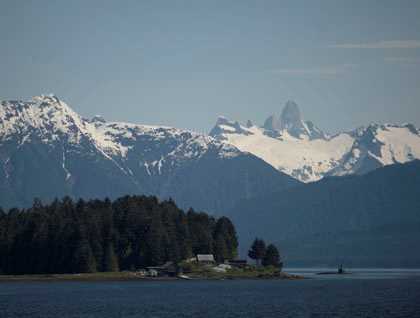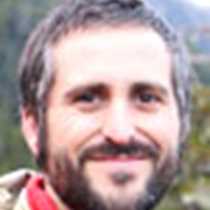Once more, we awoke to a beautiful sun-filled morning on the National Geographic Sea Lion. Though some of us were still bleary-eyed from a spectacular pre-dawn Aurora Borealis show, energy and spirits were high as we cruised further north through the forested islands of the Alexander Archipelago. From the bow of the ship, we watched Pacific loons dive below the surface in pursuit of small, schooling fish, while pairs of marbled murrelets – old-growth forest nesting birds that are increasingly endangered elsewhere, but abundant in the Alaskan fjords – called to reassure each other that they were still close by.
After breakfast, we listened to a talk on Southeast Alaskan humpback whales, and then convened on the outside deck to watch as our ship negotiated its way around the red and green buoys marking the main channel of the sinuous Wrangell Narrows. The ‘Narrows’ is a principal inside passage waterway for Alaskan ferries and tug-and-tows that connects southern and northern Southeast Alaska and terminates at the lovely Norwegian-flavored fishing town of Petersburg.
Petersburg presents many opportunities for exploration. Many of us chose to take ‘flightseeing’ tours by seaplane over the scenic Le Conte glacier, while others rode bicycles along the beaches and shorelines that fringe the town. A big highlight was the peat-bog – more commonly known as muskeg – that surrounded much of the trail on nearby Kupreanof Island. This intriguing habitat, characterized by soft blankets of sphagnum moss and heather interspersed with twisted yellow-cedars and bonsai-like shore pines, first appeared along the central coast of BC. However, not until we reached the rain-soaked mountains of Southeast Alaska did it begin to truly challenge the coastal spruce/hemlock forests for supremacy (or, at least, real estate). Even the short boat ride across the narrows from the ship to the muskeg trailhead was spectacular as it afforded great views of Devil’s Thumb, a commanding ~50 million year old mountain horn straddling the BC/Alaskan border that was spared from the grinding glaciers of the Pleistocene epoch.
For dinner, we enjoyed a delicious feast of Alaskan Dungeness crab supplied to us by our friends in Petersburg, and laughed as we dodged wayward crab pieces that inevitably sprung from the crackers of our fellow table guests and into our laps. And what finer way to end such a wonderful day than with cobbler and ice cream in the forward lounge while National Geographic photographer Macduff Everton inspired us yet again with his engaging photography and delightful travel stories.







